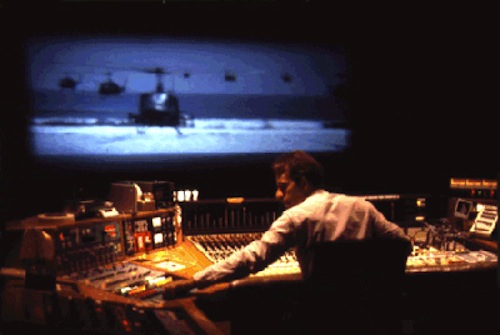Why 3D doesn’t work and never will. Case closed.

Il tizio che vedete nella foto si chiama Walter Murch, mostro sacro del montaggio e del sound-design, qui ripreso durante la lavorazione di Apocalypse Now di Coppola.
Prima che qualcuno di voi pensi che Murch sia un retrogrado incapace di adattarsi alle novità, sappiate che oltre ad aver ideato alcune tecniche di montaggio ed essere tra i creatori dell’audio multitraccia 5.1, è famoso per aver ricevuto Oscar e Nomination usando 4 tecnologie differenti:
* Julia (1977) con una moviola verticale
* Apocalypse Now (1979 – Oscar), Ghost (1990) ed Il Padrino Parte III (1990) con una moviola orizzontale KEM
* The English Patient (1996 – 2 Oscar) con Avid e
* Cold Mountain (2003) usando Final Cut Pro.
Avevo scritto un bel post ma un update della Lega me l’ha bevuto, dovrete per il momento accontentarvi dell’articolo di Roger Ebert, critico cinematografico del Chicago Sun-Times, dal titolo inequivocabile Why 3D doesn’t work and never will. Case closed. che riporta una lettera scrittagli da Murch.
Riporto la lettera completa nell’approfondimento:
[more]
[/more]
Hello Roger,I read your review of “Green Hornet” and though I haven’t seen the film, I agree with your comments about 3D.
The 3D image is dark, as you mentioned (about a camera stop darker) and small. Somehow the glasses “gather in” the image — even on a huge Imax screen — and make it seem half the scope of the same image when looked at without the glasses.
I edited one 3D film back in the 1980’s — “Captain Eo” — and also noticed that horizontal movement will strobe much sooner in 3D than it does in 2D. This was true then, and it is still true now. It has something to do with the amount of brain power dedicated to studying the edges of things. The more conscious we are of edges, the earlier strobing kicks in.
The biggest problem with 3D, though, is the “convergence/focus” issue. A couple of the other issues — darkness and “smallness” — are at least theoretically solvable. But the deeper problem is that the audience must focus their eyes at the plane of the screen — say it is 80 feet away. This is constant no matter what.
But their eyes must converge at perhaps 10 feet away, then 60 feet, then 120 feet, and so on, depending on what the illusion is. So 3D films require us to focus at one distance and converge at another. And 600 million years of evolution has never presented this problem before. All living things with eyes have always focussed and converged at the same point.
If we look at the salt shaker on the table, close to us, we focus at six feet and our eyeballs converge (tilt in) at six feet. Imagine the base of a triangle between your eyes and the apex of the triangle resting on the thing you are looking at. But then look out the window and you focus at sixty feet and converge also at sixty feet. That imaginary triangle has now “opened up” so that your lines of sight are almost — almost — parallel to each other.
We can do this. 3D films would not work if we couldn’t. But it is like tapping your head and rubbing your stomach at the same time, difficult. So the “CPU” of our perceptual brain has to work extra hard, which is why after 20 minutes or so many people get headaches. They are doing something that 600 million years of evolution never prepared them for. This is a deep problem, which no amount of technical tweaking can fix. Nothing will fix it short of producing true “holographic” images.
Consequently, the editing of 3D films cannot be as rapid as for 2D films, because of this shifting of convergence: it takes a number of milliseconds for the brain/eye to “get” what the space of each shot is and adjust.
And lastly, the question of immersion. 3D films remind the audience that they are in a certain “perspective” relationship to the image. It is almost a Brechtian trick. Whereas if the film story has really gripped an audience they are “in” the picture in a kind of dreamlike “spaceless” space. So a good story will give you more dimensionality than you can ever cope with.
So: dark, small, stroby, headache inducing, alienating. And expensive. The question is: how long will it take people to realize and get fed up?
All best wishes,
Walter Murch
Se avrete la pazienza di leggerla troverete una serie di spiegazioni – non solo strettamente tecniche – sul perchè il 3D sarà una tecnologia che fa vendere ma non è adatta al cinema sul grande schermo.
Ma se la domanda è “how long will it take people to realize and get fed up?”, beh, noi ci siamo già arrivati da un po’.





